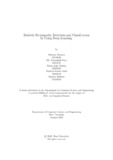Diabetic retinopathy detection and classification by using deep learning
Date
2022-01Publisher
Brac UniversityAuthor
Hossain, ShahriarEvan, Md. Nurusshafi
Farhin, Fariya Zakir
Nabil, Mashrur Karim
Sadman, Sameen
Metadata
Show full item recordAbstract
Eyes are the most sensitive part of a human being and it is one of the most challenging
tasks for a computer-aided system to classify its diseases. Many visionthreatening
diseases such as, Glaucoma and Diabetic Retinopathy are treated using
digital fundus imaging and retinal images by the specialist at a primary level. However,
a computer-aided system that can classify if the eye has a disease or not could
be a handy tool for the specialists and a challenging task for computer aided system
developers. A branch of machine learning which is deep learning is making a revolutionary
impact on medical diagnosis using image processing and pattern recognition.
Therefore, we aim to make use of some Convolutional Neural Network (CNN) architectures
such as ResNet50, Inception V3, Xception, DenseNet-169 and MobileNetV3
Large to extract the features and classify if the eye has a disease or not using digital
fundus photography and retinal image. For our research, we used a competition
dataset available from Kaggle [1] and another dataset from IDRiD [2]. Our final
dataset contained a total of 2,517 images with each stage having around 500 images
in them. Upon training and testing the selected architectures, we have found that
Inception V3 has an accuracy of 86.31% and 87.7% (with a lowered learning rate).
Similarly for Xception, we attained 86.9% accuracy with default learning rate and
87.9% accuracy with lowered learning rate. ResNet50 gave an accuracy of 46.83%,
MobileNetV3 Large gave the lowest accuracy standing at 23.81%. DenseNet-169
gave us the highest accuracy among all other models, soaring at 88.29% accuracy.

